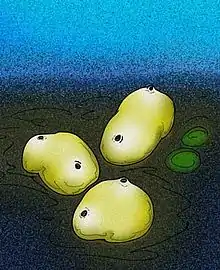Yarnemia
Yarnemia ascidiformis is a fossil tentatively classified as a tunicate. While Y. ascidiformis looks similar to tunicates, the oldest unequivocal tunicate, Shankouclava[1] dates to the Cambrian period, while Y. ascidiformis is Ediacaran in age.[2][3]
| Yarnemia Temporal range: Ediacaran | |
|---|---|
 | |
| reconstruction as a tunicate-like animal | |
| Scientific classification | |
| Domain: | Eukaryota |
| Kingdom: | Animalia |
| Phylum: | Chordata |
| Subphylum: | Tunicata (?) |
| Genus: | †Yarnemia Nesov in Chistyakov et al., 1984 |
| Species: | †Y. ascidiformis |
| Binomial name | |
| †Yarnemia ascidiformis Nesov in Chistyakov et al., 1984 | |
Etymology
The generic name Yarnemia comes from the village of Yarnema near which the first specimens were found. The specific epithet, ascidiformis, refers to the likeness to ascidians.
See also
Other Ediacaran biota tentatively identified as tunicates include
References
- Chen, Jun-Yuan, et al. "The first tunicate from the Early Cambrian of South China." Proceedings of the National Academy of Sciences 100.14 (2003): 8314-8318.
- University of California Museum of Paleontology Berkeley
- Chistyakov, V.G.; Kalmykova, N.A.; Nesov, L.A. & Suslov, G.A. (1984). "О наличии вендских отложений в среднем течении р. Онеги и возможном существовании оболочечников (Tunicata: Chordata) в докембрии" [On the Presence of Vendian Deposits in the Middle Course of the Onega River and Presumable Existence of Tunica (Tunicata: Chordata) in Precambrian] (PDF). Vest. Leningrad. Gos. Univ. (LGU) (in Russian). 6: 11–19. Archived from the original (PDF) on February 7, 2007.
This article is issued from Wikipedia. The text is licensed under Creative Commons - Attribution - Sharealike. Additional terms may apply for the media files.